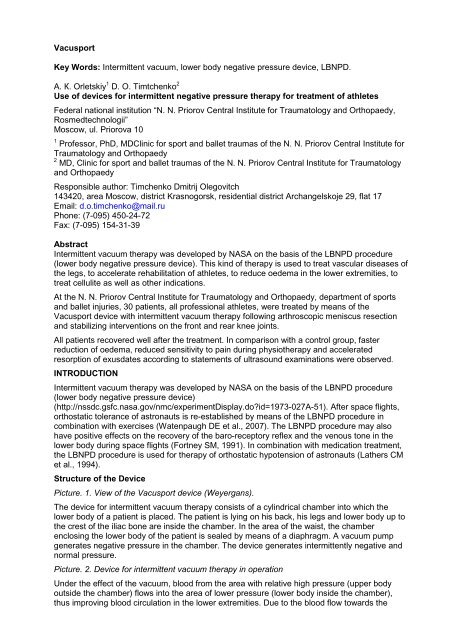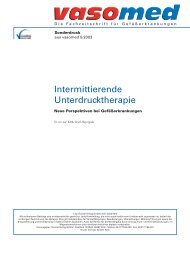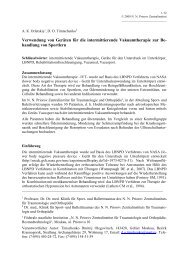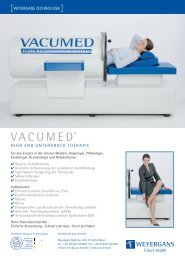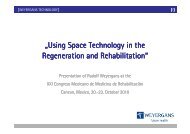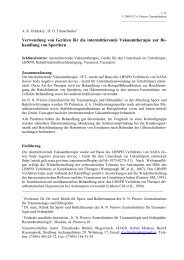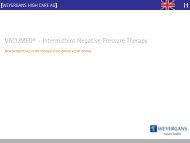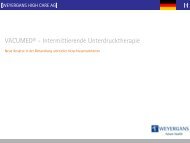Intermittent vacuum, lower body negative pressure ... - vacumed
Intermittent vacuum, lower body negative pressure ... - vacumed
Intermittent vacuum, lower body negative pressure ... - vacumed
- No tags were found...
You also want an ePaper? Increase the reach of your titles
YUMPU automatically turns print PDFs into web optimized ePapers that Google loves.
VacusportKey Words: <strong>Intermittent</strong> <strong>vacuum</strong>, <strong>lower</strong> <strong>body</strong> <strong>negative</strong> <strong>pressure</strong> device, LBNPD.А. К. Orletskiy 1 D. О. Timtchenko 2Use of devices for intermittent <strong>negative</strong> <strong>pressure</strong> therapy for treatment of athletesFederal national institution “N. N. Priorov Central Institute for Traumatology and Orthopaedy,Rosmedtechnologii”Moscow, ul. Priorova 101 Professor, PhD, MDClinic for sport and ballet traumas of the N. N. Priorov Central Institute forTraumatology and Orthopaedy2 MD, Clinic for sport and ballet traumas of the N. N. Priorov Central Institute for Traumatologyand OrthopaedyResponsible author: Timchenko Dmitrij Olegovitch143420, area Moscow, district Krasnogorsk, residential district Archangelskoje 29, flat 17Email: d.o.timchenko@mail.ruPhone: (7-095) 450-24-72Fax: (7-095) 154-31-39Abstract<strong>Intermittent</strong> <strong>vacuum</strong> therapy was developed by NASA on the basis of the LBNPD procedure(<strong>lower</strong> <strong>body</strong> <strong>negative</strong> <strong>pressure</strong> device). This kind of therapy is used to treat vascular diseases ofthe legs, to accelerate rehabilitation of athletes, to reduce oedema in the <strong>lower</strong> extremities, totreat cellulite as well as other indications.At the N. N. Priorov Central Institute for Traumatology and Orthopaedy, department of sportsand ballet injuries, 30 patients, all professional athletes, were treated by means of theVacusport device with intermittent <strong>vacuum</strong> therapy following arthroscopic meniscus resectionand stabilizing interventions on the front and rear knee joints.All patients recovered well after the treatment. In comparison with a control group, fasterreduction of oedema, reduced sensitivity to pain during physiotherapy and acceleratedresorption of exusdates according to statements of ultrasound examinations were observed.INTRODUCTION<strong>Intermittent</strong> <strong>vacuum</strong> therapy was developed by NASA on the basis of the LBNPD procedure(<strong>lower</strong> <strong>body</strong> <strong>negative</strong> <strong>pressure</strong> device)(http://nssdc.gsfc.nasa.gov/nmc/experimentDisplay.do?id=1973-027A-51). After space flights,orthostatic tolerance of astronauts is re-established by means of the LBNPD procedure incombination with exercises (Watenpaugh DE et al., 2007). The LBNPD procedure may alsohave positive effects on the recovery of the baro-receptory reflex and the venous tone in the<strong>lower</strong> <strong>body</strong> during space flights (Fortney SM, 1991). In combination with medication treatment,the LBNPD procedure is used for therapy of orthostatic hypotension of astronauts (Lathers CMet al., 1994).Structure of the DevicePicture. 1. View of the Vacusport device (Weyergans).The device for intermittent <strong>vacuum</strong> therapy consists of a cylindrical chamber into which the<strong>lower</strong> <strong>body</strong> of a patient is placed. The patient is lying on his back, his legs and <strong>lower</strong> <strong>body</strong> up tothe crest of the iliac bone are inside the chamber. In the area of the waist, the chamberenclosing the <strong>lower</strong> <strong>body</strong> of the patient is sealed by means of a diaphragm. A <strong>vacuum</strong> pumpgenerates <strong>negative</strong> <strong>pressure</strong> in the chamber. The device generates intermittently <strong>negative</strong> andnormal <strong>pressure</strong>.Picture. 2. Device for intermittent <strong>vacuum</strong> therapy in operationUnder the effect of the <strong>vacuum</strong>, blood from the area with relative high <strong>pressure</strong> (upper <strong>body</strong>outside the chamber) flows into the area of <strong>lower</strong> <strong>pressure</strong> (<strong>lower</strong> <strong>body</strong> inside the chamber),thus improving blood circulation in the <strong>lower</strong> extremities. Due to the blood flow towards the
<strong>lower</strong> extremities, the mean blood <strong>pressure</strong> falls. Normally, the <strong>body</strong> compensates for theredistribution of blood by increasing the pulse rate and peripheral vascular constriction. Due tothe blood flow towards the <strong>lower</strong> extremities, the mean blood <strong>pressure</strong> falls (Repetition in theoriginal; translator’s remark). (http://nssdc.gsfc.nasa.gov/nmc/experimentDisplay.do?id=1973-027A-51; Esch BT et al., 2007).Physiological PrinciplesThe <strong>negative</strong> <strong>pressure</strong> in the <strong>lower</strong> <strong>body</strong> is used in order to model gravity and bleeding, tochange initial tension and effect on baro-receptors as well as to examine patients with cardiacinsufficiency, athletes, astronauts and elderly people (Esch BT et al., 2007).Using <strong>negative</strong> <strong>pressure</strong> in the <strong>lower</strong> <strong>body</strong> makes it possible to control venous reflux and thusmodel-controlled hypovolemia (Nette RW et al., 2003).Low <strong>pressure</strong> in the <strong>lower</strong> <strong>body</strong> is used to simulate exsanguinations and to model orthostaticstress because several changes of neuro-vascular physiology are similar for upright and bent<strong>body</strong> positions. Both relief the cardio-pulmonary and arterial baro-receptors to a certain degree.However, there are differences in local events in blood vessels. In contrast to a bent <strong>body</strong>position, visceral vessels are obliterated as a result of intermittent <strong>vacuum</strong> therapy. Vessels areobliterated in proportion to the <strong>negative</strong> <strong>pressure</strong>; venous constriction is supported (Taneja I etal., 2007).Due to the <strong>negative</strong> <strong>pressure</strong> in the chamber, the <strong>negative</strong> <strong>pressure</strong> in the <strong>lower</strong> <strong>body</strong> triggersthe movement of the circulating blood volume into <strong>lower</strong> extremities and abdomen. This bloodmovement results in <strong>lower</strong>ing the blood <strong>pressure</strong> in the central vein, heart beat volume, cardiacoutput and, finally, in <strong>lower</strong>ing the arterial blood <strong>pressure</strong>, which must be met by compensationmechanisms. All in all, the short-term reaction is a changed total resistance of blood stream,venous tone, frequency and width of heart contractions (Kappel F et al., 2007; Hisdal J et al.,2001).The cardiovascular system reacts to the reduced heart beat volume and blood <strong>pressure</strong> in thecentral vein by increasing the pulse and the peripheral vessel resistance. This reaction includesreduction of the parasympathetic effect on the heart, activation of the sympathetic response tothe heart and the peripheral vessels, increase of the catecholamine secretion, of theplasmarenin activity and reduction of the release of the atrial natriuretic peptide (Gasiorowska Aet al., 2006).Directly proportional to the effective <strong>negative</strong> <strong>pressure</strong> in the <strong>lower</strong> <strong>body</strong>, the amounts ofdeoxygenized and overall haemoglobin in the muscles of the <strong>lower</strong> extremities are increased.The amount of oxygenized haemoglobin is increased considerably at -10 mmHg, and the curveof the amount of oxygenized haemoglobin in relation to the effective <strong>negative</strong> <strong>pressure</strong>becomes constant when the <strong>pressure</strong> is increased further. The increased amount ofdeoxygenized and of overall haemoglobin may be an indication for blood retention in the venoussystem and adjustment of the blood volume to the changed <strong>pressure</strong> in the <strong>lower</strong> <strong>body</strong>. On theother hand, the changed oxygenized haemoglobin reflects the collection of blood in the arterialsystem of the correlation of mechanical extension and sympathetic vascular constriction causedby the <strong>negative</strong> <strong>pressure</strong> (Hachiya T et al., 2004).For healthy volunteers, <strong>negative</strong> <strong>pressure</strong> in the <strong>lower</strong> <strong>body</strong> results in <strong>lower</strong> blood <strong>pressure</strong> inthe central vein starting from a <strong>negative</strong> <strong>pressure</strong> of -20 mmHg, while higher values cause adecreased heart beat volume and cardiac indicators (Nette RW et al., 2003).It is generally assumed that the <strong>negative</strong> <strong>pressure</strong> in the <strong>lower</strong> <strong>body</strong> up to a value of – 20 mmHgdoes not change the mean blood <strong>pressure</strong> (Hisdal J et al., 2001). Due to the increase of theoverall peripheral resistance and the pulse, the arterial blood <strong>pressure</strong> usually remainsunchanged; however, at a <strong>negative</strong> <strong>pressure</strong> of -40 mmHg and less, hypotension may develop.In case of healthy volunteers, the hypotension risk increased with hypovolemia (Nette RW et al.,2003). Other information indicates that the systolic blood <strong>pressure</strong> at a <strong>negative</strong> <strong>pressure</strong> of -50mmHg decreases moderately, although the mean blood <strong>pressure</strong> and the diastolic blood<strong>pressure</strong> at various values of the <strong>negative</strong> <strong>pressure</strong> in the <strong>lower</strong> <strong>body</strong> remain at a certain level(Hachiya T et al., 2004).
In case of healthy volunteers, the pulse rate increases when applying <strong>negative</strong> <strong>pressure</strong> within 5minutes at -50 mmHg and in the model of orthostatic instability at a <strong>negative</strong> <strong>pressure</strong> of -30mmHg (Lathers CM et al., 1994).When examining the tolerance for <strong>negative</strong> <strong>pressure</strong> in the <strong>lower</strong> <strong>body</strong> it was observed thatyounger and more athletic men and women have a more adequate venous tone; however, thetolerance of the maximum <strong>negative</strong> <strong>pressure</strong> in the <strong>lower</strong> <strong>body</strong> does not depend on this(Hernandez JP et al., 2004).Although in there are sex differences in the adrenergetic response, which may play a role withregard to the tolerance of intermittent <strong>vacuum</strong> therapy - and it is assumed that women have a<strong>lower</strong> orthostatic tolerance – no differences between men and women were discovered in theexaminations when the blood <strong>pressure</strong> in the central vein or the cardio-vascular system andbaro-receptor reaction was changed (Franke WD et al., 2003).Physiological examinations determined that patients with diabetes type 2 show symptomaticdysfunction, however with cerebral self-regulation, which shows during intermittent <strong>vacuum</strong>therapy in <strong>lower</strong>ed arterial blood <strong>pressure</strong> and in the speed of blood circulation in the brain withaccompanying increased pulse rate, although transport function and phase displacementremain stable (Marthol H et al., 2007).The <strong>body</strong> condition responds in two ways to orthostatic tolerance. Orthostatic tolerance is theability to maintain the blood flow in the brain when the <strong>body</strong> position is changed. It is assumedthat the mechanisms to maintain the blood flow in the brain correlate with age and <strong>body</strong> condition(Hernandez JP et al., 2005).It is known that orthostatic tolerance is disrupted for persons who exercise intensively as well asfor patients who are bed-ridden. Athletes with high endurance tend to have low orthostatictolerance. When modelling orthostatism in the laboratory, athletes with high endurance have amore distinct reduction of the heart beat volume than untrained persons. Intensive enduranceexercises may reduce orthostatic tolerance by re-modelling the myocardium and by a steepervolume-<strong>pressure</strong> curve. This results in an excessive reduction of the heart beat volume inupright <strong>body</strong> position. Other mechanisms contributing to frequently occurring orthostaticintolerance of athletes include increased sensitivity of the carotid baro-receptors and reducedvascular reactivity to sympathetic stimulation as well as change of the vein tone in the <strong>lower</strong>extremities.The latter factor is the least significant. It was also demonstrated in orthostatic tests that athleticpersons have a higher filtration of the calf capillaries in a bent <strong>body</strong> position. This mechanismmay play a role in case of intolerance against heavy weight stimuli. On the other hand, someinformation indicates that aerobic stress is not related to orthostatic intolerance, and that longdistancerunners have a higher orthostatic tolerance that untrained persons. Generally, for mostpeople moderate exercises do not interfere with orthostatic tolerance, and for some people theyincrease a low tolerance (Gasiorowska A et al., 2006; Nazar K et al., 2006).Since it was shown that venous backflow into the <strong>lower</strong> extremities in case of <strong>negative</strong> <strong>pressure</strong>in the <strong>lower</strong> <strong>body</strong> is more significant than for backflow into the abdomen it is assumed that forpersons with higher venous resilience in the <strong>lower</strong> extremities <strong>negative</strong> <strong>pressure</strong> in the <strong>lower</strong><strong>body</strong> causes a higher blood reflux and therefore <strong>lower</strong> tolerance against intermittent <strong>vacuum</strong>therapy.Muscles rather than fat or bones prevent blood depots in the <strong>lower</strong> extremities. As a result,when muscular mass in the <strong>lower</strong> extremities is lost (e.g. in case a patient is bed-ridden) thevenous resilience in the <strong>lower</strong> extremities is increased. Therefore, muscle-building exercises arebound to increase tolerance against intermittent <strong>vacuum</strong> therapy (Lawler LA et al., 1998).It is known that in the course of ageing the affinity to orthostatic hypotension increases, whichmay increase the risk of falling for such persons. In a continuous examination it was establishedthat endurance training over six months increases the venous tone for elderly people while notreducing the tolerance against intermittent <strong>vacuum</strong> therapy (Hernandez JP et al., 2005).However, in a different continuous examination it was stated that neither age nor condition hasany effect on the tolerance to orthostatic stress modelled with <strong>negative</strong> <strong>pressure</strong> in the <strong>lower</strong>
ody. Although depending on age and condition, differences are observed in terms of theresponse to sub-maximum orthostatic stress; these differences are not correlated to thetolerance differences (Hernandez JP et al., 2005).Tolerance to intermittent <strong>vacuum</strong> therapy increases after repeated treatments, which isachieved by increased ability to contract of the heart ventricle, <strong>lower</strong>ed resilience of theperipheral vessels, adjustment of the reflex mechanism to hypotension correction and increasedblood <strong>pressure</strong> (Yang CB et al., 2000).The majority of the examinations of physiological effects of intermittent <strong>vacuum</strong> therapy isbased on reactions to stable <strong>negative</strong> <strong>pressure</strong> in the <strong>lower</strong> <strong>body</strong>. When adjusting the <strong>negative</strong><strong>pressure</strong> in the <strong>lower</strong> <strong>body</strong> and returning to normal <strong>pressure</strong>, transition effects can be observed,such as <strong>lower</strong>ing of the mean blood <strong>pressure</strong> when <strong>negative</strong> <strong>pressure</strong> is applied (Hisdal J et al.,2002).When a <strong>negative</strong> <strong>pressure</strong> of -20 mmHg is quickly reached and the return to normal <strong>pressure</strong>also happens quickly, change of pulse, mean blood <strong>pressure</strong> and heart beat volume areobserved. The response of the cardio-vascular system is asymmetrical, especially with regard tothe heart beat volume. When applying <strong>negative</strong> <strong>pressure</strong>, the heart beat volume decreasesslowly within 50 sec; return to normal <strong>pressure</strong> causes a fast return of the heart beat volume tothe original level within less than 10 sec. The neutral response causing the overall vesselresistance is not sufficient to compensate for a fast change of the <strong>negative</strong> <strong>pressure</strong> in the <strong>lower</strong><strong>body</strong>. The change of the mean blood <strong>pressure</strong> is caused by the fact that apart from low<strong>pressure</strong> baro-receptors also arterial baro-receptors are activated, which react to the meanblood <strong>pressure</strong> in the event of fast reaching and discarding of low <strong>negative</strong> <strong>pressure</strong> in the <strong>lower</strong><strong>body</strong> (Hisdal J et al., 2001).Changes of the haemo-dynamic values to the level of the macro-organism have to beaccompanied with perfusion changes on tissue level. In this regard, NASA and DLR (GermanCentre for Aviation and Space Travel) have stated that application of treatment devices forintermittent <strong>vacuum</strong> therapy (Vacuumed and Vacusport by Weyergans High Care AG) causesdrastic capillary dilatation and capillarization with simultaneous increase of the micro- andmacro-perfusion in the <strong>lower</strong> extremities (Lathers CM et al., 1994).Such devices are called “external heart for the <strong>lower</strong> <strong>body</strong>”. Unlike the devices used in spacemedicine, Vacustyler, Vacumed and Vacusport operate with intermittent <strong>negative</strong> <strong>pressure</strong> anddefined intervals. The alteration of <strong>negative</strong> and normal <strong>pressure</strong> increases capillarization andcapillary dilatation and increases the flow of oxygenized blood in the <strong>lower</strong> extremities. Duringthe phase of normal <strong>pressure</strong>, venous blood and lymph move into the larger vessels (increasedbackflow). The accelerated micro-perfusion and lymphatic drainage result in a pH increase. Thiscan be used to strengthen the connective tissue (increase collagen synthesis) and for cellulitetreatment which is related to disrupted lymphatic drainage according to current scientificopinion. Since different treatment methods promote different reflexes during intermittent <strong>vacuum</strong>therapy that can be used to trigger various specific responses (Goswami N et al., 2008), anextension of the <strong>negative</strong> <strong>pressure</strong> phases is used to stimulate arterial perfusion; an extensionof the normal <strong>pressure</strong> stages is used to increase backflow of venous blood and lymph(http://www.vtstyler.co.uk/Vacustyler2.htm).Effects in Case of PathologySimilar to the use for astronauts after space travel, devices for intermittent <strong>vacuum</strong> therapyhave been successfully used against orthostatic instability of bed-ridden patients (Lathers CM etal., 1993).Angiological examinations with patients suffering from chronic arterial diseases have proven animprovement of the pulse wave in the toes and an increase of the oxygen particle <strong>pressure</strong>measured through the skin after intermittent <strong>negative</strong> <strong>pressure</strong> therapy (Straminski et al., 2001;Strauss, 2001).The effectiveness of treatment with Vacumed was examined on patients suffering from arterialobstruction stage 3 and 4 according to Fontaine. The effectiveness of the treatment wasevaluated by means of measuring the pulse wave in the toes with LLR Periquant 815 (Gutman)and oxygen <strong>pressure</strong> measurement through the skin (Radiometer GmbH). The therapy included
6 treatments of 20 minutes each with intermittent <strong>negative</strong> <strong>pressure</strong> of -50 mmHg. Asignificantly increased pulse wave and oxygen particle <strong>pressure</strong> in the toes directly after the<strong>negative</strong> <strong>pressure</strong> treatment is proven (Strauss, 2001).Straminski et al. (2001) examined the effectiveness of intermittent <strong>vacuum</strong> therapy withVacumed on 10 patients suffering from arterial obstruction of stage 2 in the <strong>lower</strong> extremitiesand with clinically diagnosed disruption of peripheral micro-circulation in the feet. The therapyincluded 6 treatments of 20 minutes each with <strong>negative</strong> <strong>pressure</strong> of -40 to 50 mmHg withintervals of two to four days. The pulse wave and the oxygen particle <strong>pressure</strong> in the toes wasmeasured immediately before the treatment, during the treatment and 30 minutes after thetreatment. The oxygen particle <strong>pressure</strong> was increased by 14% during the treatment and 30minutes after the treatment it was 8% higher than before the treatment. During the treatment,increased peripheral pulsation was observed. Seven of ten patients reported a subjectiveimprovement and less discomfort.A similar examination with the Vacustyler was conducted on patients with disruptions of venousand arterial blood flow. Statements of 23 patients with disruptions of venous and arterial bloodflow (atherosclerosis, obstruction of the thigh, knee joint, shin artery, constriction of the hipartery, coronary insufficiency, arterial hypertension, diabetes, gangrene of the foot, gangrene ofthe toe, critical ischemia of the <strong>lower</strong> extremities, tropical abscess of the toes, aneurism of theabdominal aorta, amputation of the <strong>lower</strong> extremities) were recorded. Three patients sufferedfrom severe pain when walking. With accompanying medication treatment, the patients weretreated with intermittent <strong>vacuum</strong> therapy by means of Vacustyler for 5 days with 2 sessionseach day and another 10 days with 1 session each day. Normally, the first two treatments take20 minutes each at a <strong>negative</strong> <strong>pressure</strong> of -25 mmHg; then the treatment was for 35 minutes ata <strong>negative</strong> <strong>pressure</strong> of -30 mmHg. All patients recovered well after the treatment; they reporteddecreased pain and were able to walk without problems (Solveiga А., 2003).To evaluate the clinical effectiveness of intermittent <strong>vacuum</strong> therapy, Doctor Schink (2005)conducted an examination with patients suffering from stable chronic arterial diseases of stage2. The objective of the examination was to evaluate the effect of intermittent <strong>vacuum</strong> therapywith chronic arterial diseases of stage 2 on walking distance. The control group includedpatients with chronic arterial disease stage 2, which were treated with special exercises.The effect of the special exercises with chronic arterial disease had been examined in previousexaminations; the patients were able to increase the distance of pain-free walking by up to150% after 6 months of treatment (Gardner AW et al., 1995; Degischer S et al., 2002; Diehm etal., 2003). Doctor Schink et al. (2003) stated after examining 45 patients that walking exercisesand gymnastics result in an average improvement by 40% within three weeks.The examined group included 23 patients aged 61 – 82 years (average 75 years) with medicalhistories of 2 – 20 years. After a clinical examination, the patients underwent at least 10treatments (2 – 3 treatments per week) of <strong>vacuum</strong> therapy. Each treatment took 20 minutes:Alternating 5 sec. -50 mbar and 10 sec. normal <strong>pressure</strong>.The patients also carried out the normal exercises immediately within 30 minutes after thetreatment. After 10 treatments another clinical examination and interview was conducted. Allpatients recovered well after the therapy and all described the treatments as “pleasant”. Fourpatients did not feel any change in the distance of pain-free walking, 19 patients observed anincreased distance. The average increase of the distance of pain-free walking was 72% (30-130%). 23 patients received an average of 14 (10-30) treatments within an average of 5 (3-12)weeks (Schink, 2005). However, further examinations are necessary to proof the effectivenessof the treatment (Schink, 2005; Diehm et al., 2003).At the institute Euromedicine Biophyderm (Montpellier, France) a clinical examination wasconducted with 18 women aged 18 to 55 years suffering from cellulite problems. Each patientunderwent a total of 15 treatments of 30 minutes each and 2 treatments per week withVacustyler. Apart from the subjective results (reduction of the venous net, reduction of orangeskin, of skin dryness, improvement of skin tone, strengthening of the epidermis), a considerable,even reduction of the circumference of the thigh by several centimetres was stated. All patientsrecovered well after the treatment (Agopian-Simoneau L, 2003).
There are also examinations of clinical application of intermittent <strong>vacuum</strong> therapy for patientswith chronic cardiac insufficiency (Wolthuis RA et a., 1974).Effects on AthletesThe effect of manual massage or lymphatic drainage during rehabilitation of athletes is wellknown. In this method, venous backflow is stimulated and circulation of arterial and venousblood is increased, which results in increased venous backflow and cardiac output. In addition,muscle tone and concentration of endorphins in the brain is increased.The effectiveness of intermittent <strong>negative</strong> <strong>pressure</strong> therapy was examined during therehabilitation of 50 professional athletes (canoeists, swimmers, rowers, footballers, tennisplayers and track-and-field athletes). Within 12 weeks, the athletes underwent training followingtheir specific programmes. Half of these athletes received a 30-minute treatment of intermittent<strong>negative</strong> <strong>pressure</strong> by Vacumed every two days (-40 to -50 mbar, duration of the phases ofnormal/<strong>negative</strong> <strong>pressure</strong>: 7/5 sec). Simultaneously, all athletes participated in rehabilitationprogrammes developed by their trainers. The blood of all athletes was examined twice per weekbefore and after training. At the beginning and at the end of the examination, all athletesunderwent an extensive stress test. Before every training, all athletes were interviewed.A total of 1,200 blood examinations were conducted, which proof for the examined group(1.48mmol/l) in comparison with the control group (1.59 mmol/l) in the resting phase before thetraining. The examined athletes produced a smaller concentration of urea and uric acid (40 and3.9 mg/dl compared to 43 and 4.85 mg/dl for the control group); also, a <strong>lower</strong>ed creatine kinasewas found (262 U/l compared to 284 U/l). According to the results of the survey, the athletestreated with intermittent <strong>negative</strong> <strong>pressure</strong> therapy were more motivated in their exercises incomparison to the control group; they also had a better muscle tone and an overall betterrehabilitation (Alf DF, 2007).Clinical Experience of the Central Institute for Traumatology and OrthopaedyAt the N. N. Priorov Central Institute for Traumatology and Orthopaedy, department of sportsand ballet injuries, 30 patients, all professional athletes, were treated by means of theVacusport device following arthroscopic meniscus resection and stabilizing interventions on thefront and rear knee joints after intermittent <strong>vacuum</strong> therapy. For reasons of comparison, 30similar patients were selected, who received the traditional treatment. The treatment withintermittent <strong>negative</strong> <strong>pressure</strong> therapy began at the earliest seven days after the surgicaltreatment after removal of the sutures.Indications were: An oedema after operation, pain and fluid in the knee joint. Counterindications were: Infections, chronic diseases in the exacerbation phase, vascular thrombosis ofthe <strong>lower</strong> extremities. To avoid thrombo-embolic complications, all patients underwentmandatory examination of the vessels of the <strong>lower</strong> extremities by ultrasound Doppler-graphy.The existing Vacusport allowed generation of <strong>negative</strong> <strong>pressure</strong> intervals of 6 up to 12 secondswith normal <strong>pressure</strong> intervals of 5 up to 10 seconds at a <strong>negative</strong> <strong>pressure</strong> of -30 up to -60mbar, adjustable in 5 mbar increments, according to the saved programmes.Picture. 3. Control panel of the device for intermittent <strong>negative</strong> <strong>pressure</strong> therapy.<strong>Intermittent</strong> <strong>vacuum</strong> therapy was used daily in at least 10 treatments of 30 minutes eachaccording to the following schedule:- 1st – 6th minute: 35 mbar / 8 sec. <strong>negative</strong> <strong>pressure</strong> / 10 sec. pause- 7th -12th minute: 45 mbar / 10 sec. <strong>negative</strong> <strong>pressure</strong> / 8 sec. pause- 13th -18th minute: 55 mbar / 8 sec. <strong>negative</strong> <strong>pressure</strong> / 10 sec. pause- 19th - 24th minute: 60 mbar / 10 sec. <strong>negative</strong> <strong>pressure</strong> / 8 sec. pause- 25th - 30th minute: 50 mbar / 8 sec. <strong>negative</strong> <strong>pressure</strong> / 8 sec. pauseAll patients recovered well after the treatments and felt pleasant sensations in their legs afterthe third treatment. In comparison with the other patients (control group of 20 athletes) who didnot receive intermittent <strong>vacuum</strong> therapy, the examined patients showed a faster reduction of theoedema by 2 – 6 days (average 3.5) and reported less pain during physiotherapy. The check-up
ultrasound examinations of the surgically treated knee joints of the examined patientsestablished the accelerated reduction of the exudates.As a reason for this type of therapy, we see a strong physiological effect of intermittent <strong>vacuum</strong>treatment on lymphatic drainage and venous reflux, which accelerates reduction of oedema andminimizes the pain syndrome, as well as on the resorption of exusdates in the knee joint. Thisprevents venous backup for athletes, who often tend to orthostatic intolerance and developdisruption of the venous tone in the <strong>lower</strong> extremities that develop after an accident and duringtherapy.SUMMARYThe devices for <strong>negative</strong> <strong>pressure</strong> therapy of the <strong>lower</strong> extremities are an efficient tool to controlblood flow in the <strong>lower</strong> extremities. This technology developed for astronauts has a clearlypositive effect on adaptive blood flow forming in zero gravity. On the basis of this methodology,models for redistribution of blood flow in the <strong>body</strong> were developed, at the same time severalphysiological local and system effects of <strong>negative</strong> <strong>pressure</strong> in the <strong>lower</strong> <strong>body</strong> were analyzedand undesired phenomena, counter indications and tolerance limits were determined. Up tonow, no side effects were observed. The devices for intermittent <strong>vacuum</strong> therapy have a widerange of modulation options. However, intermittent <strong>vacuum</strong> therapy is only gradually used inclinics due to lacking comprehensive clinical examinations of the therapeutic effectiveness.In addition, adequate examinations of intermittent <strong>vacuum</strong> therapy in sports medicine withregard to performance and rehabilitation of athletes are still not available. There is a greatpotential for modification of the therapy programmes recommended by the manufacturer. Sinceup to now, after 40 years in the history of the devices for <strong>negative</strong> <strong>pressure</strong> therapy in the <strong>lower</strong>extremities, no side effects were observed, the use of the devices for intermittent <strong>negative</strong><strong>pressure</strong> therapy does not violate the main medical principle “Do not cause harm”. In addition,since intermittent <strong>negative</strong> <strong>pressure</strong> therapy has very strong and well examined physiologicaleffects, its controlled use in clinics may bring about clear positive clinical results. Therefore, theauthors find reason to promote a wide application of intermittent <strong>negative</strong> <strong>pressure</strong> therapy forvarious pathologies and for athletes in various combinations with other types of treatment, aswell as to conduct further examination of its effectiveness and development of the treatmentprogrammes.А. К. OrletskiyD. О. TimtchenkoBIBLIOGRAPHY1. Agopian-Simoneau L Negative <strong>pressure</strong> treatment medico-scientifically tested //EuromedicineBiophyderm. Montpellier, France – 2003. Private communication.2. Alf DF Observation of the regeneration of top athletes when using Vacusport LBNPD (<strong>lower</strong><strong>body</strong> <strong>negative</strong> <strong>pressure</strong> device) // Institute of sports medicine, Olympic Base Rhein-Ruhr. –2007. Private communication.3. Degischer S, Labs KH, Hochstrasser J, Aschwanden M, Tschoepl M, Jaeger KA Physicaltraining for intermittent claudication: a comparison of structured rehabilitation versus homebasedtraining // Vasc Med. – 2002. – V. 7, N 2. – p. 109-15.4. Diehm et al. Komlementare Medizin in der Angiologie // Cardiovasc. – 2003. – N 2. – p. 52-56.5. Esch BT, Scott JM, Warburton DE. Construction of a <strong>lower</strong> <strong>body</strong> <strong>negative</strong> <strong>pressure</strong> chamber// Adv Physiol Educ. – 2007. – V. 31, N. 1. – p. 76-81.6. Fortney SM. Development of <strong>lower</strong> <strong>body</strong> <strong>negative</strong> <strong>pressure</strong> as a countermeasure fororthostatic intolerance // J Clin Pharmacol. – 1991. – V. 31, N. 10. – p. 888-92.7. Franke WD, Johnson CP, Steinkamp JA, Wang R, Halliwill JR. Cardiovascular and autonomicresponses to <strong>lower</strong> <strong>body</strong> <strong>negative</strong> <strong>pressure</strong>: do not explain gender differences in orthostatictolerance // Clin Auton Res. – 2003. – V. 13, N. 1. – p. 36-44.
8. Gardner AW, Poehlman ET Exercise rehabilitation programs for the treatment of claudicationpain. A meta-analysis // JAMA. – 1995. – V. 274, N 12. – p. 975-80.9. Gasiorowska A, Mikulski T, Smorawiński J, Kaciuba-Uściłko H, Cybulski G, Ziemba AW,Krzemiński K, Niewiadomski W, Nazar K. Cardiovascular and neurohormonal responses to<strong>lower</strong> <strong>body</strong> <strong>negative</strong> <strong>pressure</strong> (LBNP): effect of training and 3 day bed rest // J PhysiolPharmacol. – 2006. – V. 57, N. 10. – p. 85-100.10. Goswami N, Loeppky JA, Hinghofer-Szalkay H. LBNP: past protocols and technicalconsiderations for experimental design // Aviat Space Environ Med. – 2008. – V. 79, N. 5. –p. 459-71.11. Hachiya T, Blaber AP, Saito M. Changes in superficial blood distribution in thigh muscleduring LBNP assessed by NIRS // Aviat Space Environ Med. – 2004. – V. 75, N. 2. – p. 118-22.12. Hernandez JP, Franke WD. Age- and fitness-related differences in limb venous compliancedo not affect tolerance to maximal <strong>lower</strong> <strong>body</strong> <strong>negative</strong> <strong>pressure</strong> in men and women // J ApplPhysiol. – 2004. – V. 97, N. 3. – p. 925-9.13. Hernandez JP, Franke WD. Effects of a 6-mo endurance-training program on venouscompliance and maximal <strong>lower</strong> <strong>body</strong> <strong>negative</strong> <strong>pressure</strong> in older men and women // J ApplPhysiol. – 2005. – V. 99, N. 3. – p. 1070-7.14. Hernandez JP, Karandikar A, Franke WD. Effects of age and fitness on tolerance to <strong>lower</strong><strong>body</strong> <strong>negative</strong> <strong>pressure</strong> // J Gerontol A Biol Sci Med Sci. – 2005. – V. 60, N. 6. – p. 782-6.15. Hisdal J, Toska K, Flatebo T, Walloe L Onset of mild <strong>lower</strong> <strong>body</strong> <strong>negative</strong> <strong>pressure</strong> inducestransient change in mean arterial <strong>pressure</strong> in humans // Eur J Appl Physiol. –2002. – V. 87.– p. 251–256.16. Hisdal J, Toska K, Walløe L. Beat-to-beat cardiovascular responses to rapid, lowlevelLBNP in humans // Am J Physiol Regul Integr Comp Physiol. – 2001. – V. 281, N. 1. – p. R213-21.17. Kappel F, Fink M, Batzel JJ. Aspects of control of the cardiovascular-respiratory systemduring orthostatic stress induced by <strong>lower</strong> <strong>body</strong> <strong>negative</strong> <strong>pressure</strong> // Math Biosci. – 2007. –V. 206, N. 2. – p. 273-308.18. Lathers CM, Charles JB, Schneider VS, Frey MA, Fortney S. Use of <strong>lower</strong> <strong>body</strong> <strong>negative</strong><strong>pressure</strong> to assess changes in heart rate response to orthostatic-like stress during 17 weeksof bed rest // J Clin Pharmacol. – 1994. – V. 34, N. 6. – p. 563-70.19. Lathers CM, Charles JB. Orthostatic hypotension in patients, bed rest subjects, andastronauts // J Clin Pharmacol. – 1994. – V. 34, N. 5. – p. 403-17.20. Lathers CM, Charles JB. Use of <strong>lower</strong> <strong>body</strong> <strong>negative</strong> <strong>pressure</strong> to counter symptoms oforthostatic intolerance in patients, bed rest subjects, and astronauts // J Clin Pharmacol. –1993. – V. 33, N. 11. – p. 1071-85.21. Lawler LA, Halliwill JR, Summer JM, Joyner MJ, Mulvagh ShL. Leg mass and <strong>lower</strong> <strong>body</strong><strong>negative</strong> <strong>pressure</strong> tolerance in men and women // J Appl Physiol. – 1998. – V. 85. – p. 1471-147522. Lower <strong>body</strong> <strong>negative</strong> <strong>pressure</strong> [Electronic resource] NSSDC ID: 1973-027A-51 MissionName: Skylab Principal Investigator: Dr. Richard L. Johnson / NASA – NSSDC – Experiment– Details. – NASA Official: Dr. Ed Grayzeck, Curator: E. Bell, II, Version 4.0.8, 05 August2008. – Zugang: http://nssdc.gsfc.nasa.gov/nmc/experimentDisplay.do?id=1973-027A-51 –frei23. Marthol H, Zikeli U, Brown CM, Tutaj M, Hilz MJ. Cardiovascular and cerebrovascularresponses to <strong>lower</strong> <strong>body</strong> <strong>negative</strong> <strong>pressure</strong> in type 2 diabetic patients // J Neurol Sci. –2007. – V. 252, N. 2. – p. 99-105.24. Nazar K,.Gasiorowska A, Mikulski T, Cybulski G, Niewiadomski W, Smorawiñski J,Krzemiñski K, Ziemba AW, Dorsz A, Kaciuba-Uscilko H. Effect Of 6-Week Endurance
Training On Hemodynamic And Neurohormonal Responses To Lower BodyNegativePressure (LBNP) In Healthy Young Men // Journal Of Physiology AndPharmacology. – 2006. V. 57, N. 2. – p. 177-188.25. Nette RW, Krepel HP, Dorpel MA, Meiracker AH, Paldermans D, Boomsma F, Weimar W,Zietse R Hemodynamic response to Lower Body Negative Pressure in Hemodialysis Patiens// American Journal of Kidney Diseases. – 2003. – V. 41, N 4. – p. 807-81326. Schink Prospective study of clinical effectiveness of intermittent low <strong>pressure</strong> treatment inpatient with chronic arterial disease (CAD) in the <strong>lower</strong> limbs grade 2 // Clinic Fallinbostel. –2005. Private communication.27. Solveiga А Investigation of Vacustyler using for patients with venous and arterial bloodcirculation disturbance // SIA “Stella-A.B.” Latvia. – 2003. Private communication.28. Straminski Result of clinical examination // Surgery Koln. – 2001. Private communication.29. Strauss Result of clinical examination // Dominikus hospital, Dusseldorf-Heerdt. – 2001.Private communication.30. Taneja I, Moran C, Medow MS, Glover JL, Montgomery LD, Stewart JM. Differential effectsof <strong>lower</strong> <strong>body</strong> <strong>negative</strong> <strong>pressure</strong> and upright tilt on splanchnic blood volume // Am J PhysiolHeart Circ Physiol. – 2007. – V. 292, N. 3. – p. 1420-6.31. VacuStyler [Electronic resource] // VT STYLER London HIGH CARE by Weyergans – 2002-2003. – Access: http://www.vtstyler.co.uk/Vacustyler2.htm – free32. Watenpaugh DE, O'Leary DD, Schneider SM, Lee SM, Macias BR, Tanaka K, Hughson RL,Hargens AR. Lower <strong>body</strong> <strong>negative</strong> <strong>pressure</strong> exercise plus brief postexercise <strong>lower</strong> <strong>body</strong><strong>negative</strong> <strong>pressure</strong> improve post-bed rest orthostatic tolerance // J Appl Physiol. – 2007. – V.103, N. 6. – p. 1964-72.33. Wolthuis RA, Bergman SA, Nicogossian AE Physiological effects of locally applied reduced<strong>pressure</strong> in man // Physiological reviews. – 1974. V. 54, N. 3. – p. 566-591.34. Yang CB, Yao YJ, Wei YB, Wu YH, Sun XQ, Wu XY. Effects of repeated low <strong>body</strong> <strong>negative</strong><strong>pressure</strong> (LBNP) exposures on LBNP tolerance // Space Med Med Eng (Beijing). – 2000. –V. 13, N. 1. – p. 10-3.__


